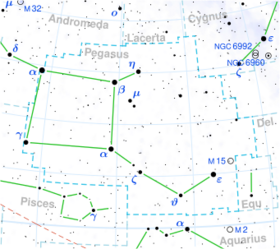Astronomy:Lambda Pegasi
From HandWiki
Short description: Fourth-magnitude star in the constellation Pegasus
| Observation data Equinox J2000.0]] (ICRS) | |
|---|---|
| Constellation | Pegasus |
| Right ascension | 22h 46m 31.87786s[1] |
| Declination | +23° 33′ 56.3561″[1] |
| Apparent magnitude (V) | 3.93[2] |
| Characteristics | |
| Spectral type | G8II-III[3] |
| U−B color index | +0.93[2] |
| B−V color index | +1.07[2] |
| Astrometry | |
| Radial velocity (Rv) | -4.15[4] km/s |
| Proper motion (μ) | RA: 55.75[1] mas/yr Dec.: -10.15[1] mas/yr |
| Parallax (π) | 8.93 ± 0.24[1] mas |
| Distance | 365 ± 10 ly (112 ± 3 pc) |
| Absolute magnitude (MV) | -1.45[5] |
| Details | |
| Mass | ~1,5[3] M☉ |
| Radius | 28.5[3][6] R☉ |
| Luminosity | 390[3] L☉ |
| Temperature | 4,933[7] K |
| Metallicity [Fe/H] | 0.12[7] dex |
| Rotational velocity (v sin i) | 8.0[8] km/s |
| Other designations | |
| Database references | |
| SIMBAD | data |
Coordinates: ![]() 22h 46m 31.9s, +23° 33′ 56.0″
22h 46m 31.9s, +23° 33′ 56.0″
Lambda Pegasi (λ Peg, λ Pegasi) is a fourth-magnitude star in the constellation Pegasus.
λ Pegasi is a yellow giant with stellar classification G8II-III. With a mass of 1.5 M☉ and radius that is 28.5 R☉, the star boasts a bolometric luminosity that is roughly 390 L☉.[3] Its apparent magnitude was calibrated in 1983 at 3.96, yielding an absolute magnitude of -1.45.[5] Parallax calculations place the star at a distance of roughly 112 parsecs from Earth, or 365 ± 10 light years away,[1] about three times the distance of its line-of-sight double μ Pegasi.
In the constellation, Lambda and Mu lie to the southwest of Beta Pegasi, the nearest bright star.
References
- ↑ 1.0 1.1 1.2 1.3 1.4 1.5 van Leeuwen, F. (November 2007). "Validation of the new Hipparcos reduction". Astronomy and Astrophysics 474 (2): 653–664. doi:10.1051/0004-6361:20078357. Bibcode: 2007A&A...474..653V.
- ↑ 2.0 2.1 2.2 Ducati, J. R (2002). "VizieR Online Data Catalog: Catalogue of Stellar Photometry in Johnson's 11-color system". CDS/ADC Collection of Electronic Catalogues 2237. Bibcode: 2002yCat.2237....0D.
- ↑ 3.0 3.1 3.2 3.3 3.4 Smith, G. (November 1998). "Stellar atmospheric parameters for the giant stars MU Pegasi and lambda Pegasi". Astronomy & Astrophysics 339: 531–536. Bibcode: 1998A&A...339..531S. http://articles.adsabs.harvard.edu/cgi-bin/nph-iarticle_query?1998A%26A...339..531S&data_type=PDF_HIGH&whole_paper=YES&type=PRINTER&filetype=.pdf. Retrieved 2012-08-28.
- ↑ Soubiran, C; Bienaymé, O; Mishenina, T. V; Kovtyukh, V. V (2008). "Vertical distribution of Galactic disk stars. IV. AMR and AVR from clump giants". Astronomy and Astrophysics 480 (1): 91–101. doi:10.1051/0004-6361:20078788. Bibcode: 2008A&A...480...91S.
- ↑ 5.0 5.1 "λ Pegasi". Wolfram Alpha. http://www.wolframalpha.com/input/?i=lambda+pegasi. Retrieved 2012-08-28.
- ↑ Kaler, James B.. "SADALBARI (Lambda and Mu Pegasi)". Stars. University of Illinois. http://stars.astro.illinois.edu/sow/sadalbari.html. Retrieved 2012-08-28.
- ↑ 7.0 7.1 Koleva, M.; Vazdekis, A. (February 2012). "Stellar population models in the UV. I. Characterisation of the New Generation Stellar Library". Astronomy & Astrophysics 538, id.A143: A143. doi:10.1051/0004-6361/201118065. Bibcode: 2012A&A...538A.143K.
- ↑ Hekker, S.; Meléndez, J. (December 2007). "Precise radial velocities of giant stars. III. Spectroscopic stellar parameters". Astronomy and Astrophysics 475 (3): 1003–1009. doi:10.1051/0004-6361:20078233. Bibcode: 2007A&A...475.1003H.
 |


